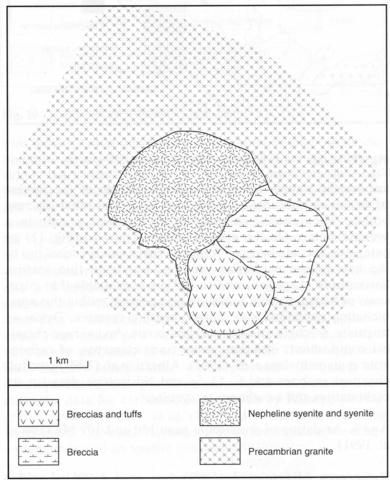stripes
Chianga is some 4 km in diameter, is deeply eroded and displays little relief. It consists principally of tuffs and/or breccias and syenites, but because of heavy alteration Lapido-Loureiro (1973) could not be certain of the identification of the syenites. He notes nepheline syenite as occurring as loose blocks over the whole area and this is described by Polinard (1939) as containing phenocrysts of nepheline, partly altered to cancrinite, alkali feldspar, aegirine and melanite in a matrix of the same minerals plus accessory apatite, titanite and calcite. He also describes trachytes, but with no field relationships, which are very fine-grained with few minerals identifiable; a chemical analysis gave 10.02% K2O and 1.92% Na2O. Carbonatites form small lenses and veins in the brecciated rocks. These breccias consist of fragments of monzonitic and biotite granite and phonolite in a matrix of K-feldspar, andesine, biotite, calcite, aegirine and a sodic amphibole.
LAPIDO-LOUREIRO, F.E. 1973. Carbonatitos de Angola. Memórias e Trabalhos do Instituto de Investigação Científica de Angola, 11: 1-242.POLINARD, E. 1939. Les roches alcalines de Chianga (Angola) et les tufs associés. Mémoires, Institut Royal Colonial Belge, Section des Sciences Naturelles et Mèdicales, Ser 8, 9(4): 1-33.

